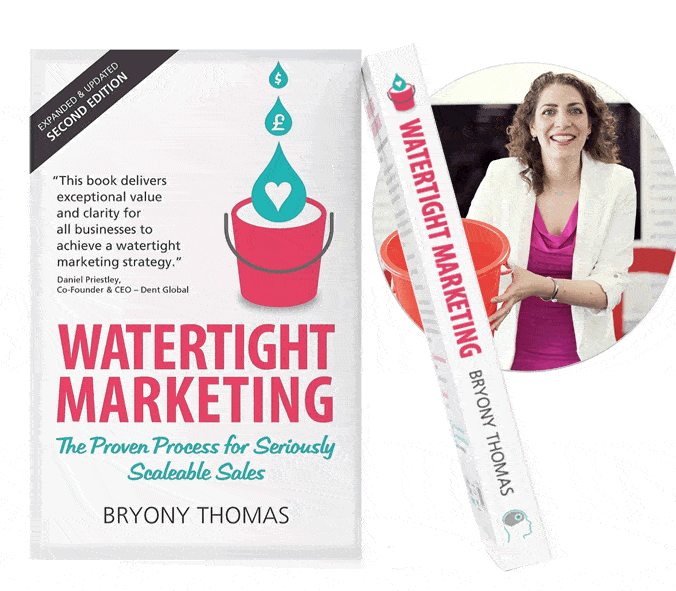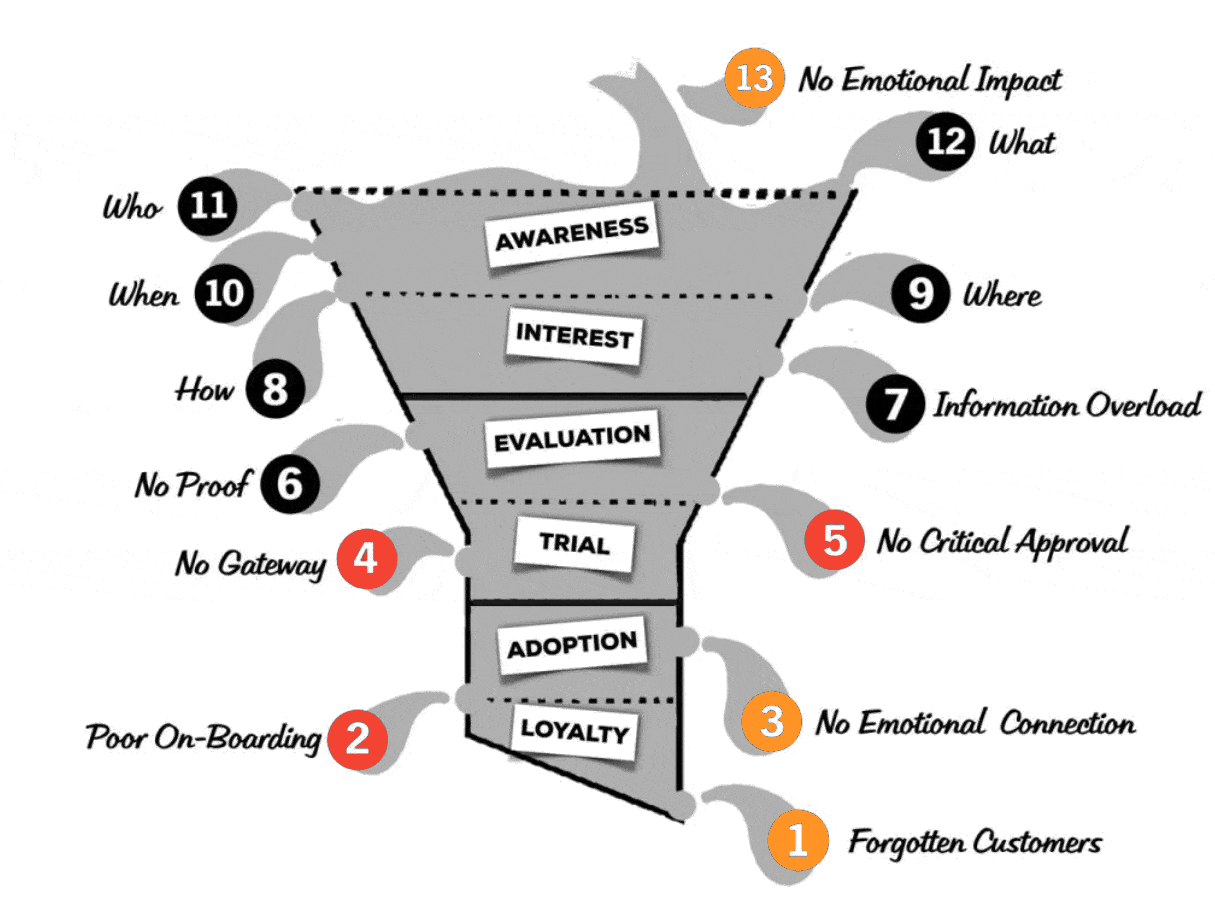Are we “leaking” web design clients?
For this first post on getting clients I’m revisiting one of my favourite books. It’s a long time bestseller, we based a series around, on the WP Builds podcast. It’s called Watertight Marketing.
Amazingly, you can now grab it for free thanks to the outstanding generosity of its author Bryony Thomas.
Here, I will be using one of its concepts to highlight how agile approaches might help with obstacles a potential client may have on their journey to finding us.
I will be exaggerating and over-generalising here but only to contrast approaches succinctly.
The aim of this blog is to present fresh perspectives. I’ll rarely say “you should do this” but I hope that bouncing around ideas can help in finding our own ways.
The Sales Funnel concept
Watertight Marketing shows us that the funnel is really not like a funnel. A better metaphor might be a leaky bucket.
It identifies 13 potential “leaks” where sales can be lost if the purchase has to be considered. The diagram shows where the “leaks” can occur in the buyer’s journey.
As suggested, I’ve coloured the leaks to highlight potential problem areas.
The book also suggests we build backwards so I’m starting at the bottom of the funnel and commenting on the leaks marked in red and amber.
As I am wanting to rebuild my business, I’m most interested in the top of the funnel which will be the last thing I will cover here.
1. Forgotten Customers
Not engaging enough to get repeat custom or recommendations.
Have I gone mad?
Most web designers seem to survive entirely on referrals with almost no marketing effort. Over recent years many are constantly engaging clients through ongoing care plans.
Forgive me! This is my way of questioning whether traditional approaches have started to had their day in web design?
From an agile perspective…
It’s baffling why any business would want to run a live media outlet via large fixed time projects. It’s setting them up to be optimal for only the short periods after each new project is completed.
Presently, this may not be too problematic for a static brochure site, but the more clients make use of the benefits of the medium, the more they will see it’s one that constantly needs adapting to.
Of course, website care plans offer route agility, but they are often presented after the traditional project mindset has been reinforced.
This can mean:
- The care plan becomes an upsell. Sold often using last minute scare tactics. Those who accepted it were ambushed. Those who reject suffer problems the designer kept to themselves up to this point.
- The traditional “Us and Them” working relationship established in the traditional project may continue through to the plan. The web designer is positioned as the outsider who does what the client wants according to a set of fixed terms.
- If we share our inside knowledge to alert companies of changes that may affect their business (GDPR, Core Web Vitals, new accessibility rules etc.) genuine intentions could be viewed as sneaky upsell.
The best and the worst thing about the traditional model is that it is the traditional model. Everyone understands it, but it was established to meet the needs of a different medium and time.
Of course, many clients will expect a traditional arrangement. Perhaps mostly with the long established (slower to respond) ones with decent budgets.
In the short term, it seems easier and more lucrative to oblige them in using up their allocated budget.
But I think we have to question how long these clients will see their websites as essentially static and suited to project based improvements. Particularly, as many larger companies are getting exposed to agile from elsewhere.
I think we already are seeing many clients finding their own route to agility via page builders and trained inhouse staff.
I feel many web designers are going the opposite way to most other industries.
The threat of page builders and DIY work seems to have reinforced the idea that it’s better to focus on pitching for big projects.
I plan to explore how to present agile approaches to customers who expect fixed cost proposals in another post.
My belief is that many of the companies who are DIYing their own sites are not doing it primarily to save money. It’s because the traditional model is no longer meeting their ongoing needs. Meet the needs and the money follows.
2. Poor On-Boarding
The critical time between a person buying and when they consider themselves a loyal customer.
I’ve marked this as red because of the amount of discussion (and software tools) focussed on the problem of getting content from clients .
Under the traditional “Us and Them” contract the client often falls at the first hurdle. What do we do?
- Rip up the contract? Kill it with drama from the start.
- Budgeted for it? Penalise the well prepared clients.
- Suck it up? Ridicule them on the Clients from Hell site.
From an agile perspective…
This is a shared problem for the client/designer team. If needed, the first sprint could just be about that.
Given the key reason for getting a web designer is often more leads and/or pretty sites it makes sense for them to work together on the very foundation for achieving that.
Of course, when a client determines their budget through sprints they are only likely to delay if genuinely needing help.
It can also stop the attempts to “bang square pegs into round holes” with one size fits all documentations and automated content grabbing software.
3. No Emotional Connection
Limited human touch, leading the potential customer to question whether to buy from you. In short, people buy from people.
Often, a lot of personal time is given to understanding a brief.
But, a high risk decision has to be made based on reading proposals that end with a sobering contract. To be a legally effective contract for a large fixed cost project it needs to assume bad faith.
It explains in no trust terms what can go wrong with what they are being asked to sign to.
From an agile perspective…
A contract (if required) only needs to extend to one low risk sprint and focuses on the team working.
The relationship from the start is not focused on the onerous tasks in nailing down the end deliverable, but on strengthening the relationship itself.
4. No Gateway
When the purchase seems like a big leap, people will defer their decision. This is where you need to create smaller stepping stones.
I started building sites when there was a big “No spec work” movement going on in the web industry.
It was about saving clients from themselves as they would indirectly be paying for something that would not help them find the best agency for them.
A right move, but it removed what seemed to clients like a helpful gateway.
From an agile perspective…
A stepping stone could be a low risk sprint of work.
Ideally something that could still be used even if the working relationship was not right.
Paid upfront and probably there is no need to contract it. You simply start.
5. No Critical Approval
Before spending a lot of money a buyer often consults or has to consult a third party. If that person says no it will rarely proceed.
This can happen at the proposal stage, but also earlier in the evaluation stage.
The potential client consults with others and comes up with new considerations and questions that use up a lot of time.
Often if nothing moves forward they get labelled as “tyre kicker”, but I think this is a poor metaphor.
It comes from car showrooms where it should be expected because of the desire to see things of great beauty or engineering.
The web design equivalent would be looking at other websites not enquiring about making our own.
From an agile perspective…
We can not answer many questions upfront. That was the whole point of it. When they are ready, we can start and find the answers by doing. It can be the thing in a low risk sprint.
13. No emotional impact
To grab attention, it needs to be meaningful to the emotional context of a client’s life or it goes unnoticed.
We probably hate to admit it, but we also know that we make decisions emotionally and then set about justifying them with logic.
If we are personally liked within a network of potential buyers, it is likely they will find more logical reasons to go with us than someone unknown.
Trust in those closest to us is in our DNA due to our dependency at birth.
The typical marketing messages of more business leads and gorgeous websites may strike an emotional chord with some. But, any emotional impulse is instantly killed when they have to work to find out what they can get for their money.
If all we have is hackneyed marketing promises that leave all the risks with the client we push them into depending on more logical thinking .
If we don’t already have trust based referrals or an existing relationship, moving a sale forward with a traditional model is not easy.
From an agile perspective…
There is not much on this. The concentration has mostly been on working with a medium that is ever changing.
Yet, I think agile’s focus on individuals and collaborations can help us take a wider perspective.
Someone, like me, who can’t easily network (due to travel) and has little interest in sales needs other ways to grab attention.
Recently I’ve started to think about the things I regularly pass on to clients regarding website visitors. That, perhaps, I ought to take my own medicine when it comes to potential clients.
Here are a few of the borrowed wisdoms I’ve applied to websites:
- The visitor needs to be the hero of the story you are telling/selling (credit to Donald Miller StoryBrand).
- Visitors are looking to be better versions of themselves (credit to Daniel Pink’s Drive for showing how mastery and self determination outweighs financial concerns).
- Visitors need to be able to visualise the benefits to them (everyone, ever).
If we think about these it is not hard to see why some clients struggle to leave us to our jobs and why many will be attracted to the promises of page builders.
I don’t believe DIY technology needs to be a threat to our web design businesses. I think it can instead offer ways to work collaboratively.
It is too easy to write off potential clients who do DIY as cheapskates. They are using what knowledge they have presently to obtain the most flexible and low risk option. What they will eventually spend is unknown and will depend on results.
I’d like to see less clients coming to me after they have already started themselves.
Often the work I see is great, but due to things most of us don’t realize for years I do not want to help unless rebuilding entirely. I’d like to reach them earlier in their journey.
Of course, this is a topic for another post, but in the end I wanted to float the idea that we can make an emotional impact simply by changing our messaging from “what we can do for you” to “let us show you what you can do”.
Notes from Watertight Marketing
STAGES IN THE CLIENT JOURNEY
Awareness (Audience): They notice you offer something that could help.
Interest (Respondents): They decide to find out a little bit more.
Evaluation: (Leads ) They see if you look credible.
Trial (Proposals): They find out what it would be like to buy from you.
Adoption (Sales): They become customers.
Loyalty (Renewals): They keep buying and tell others about you.

